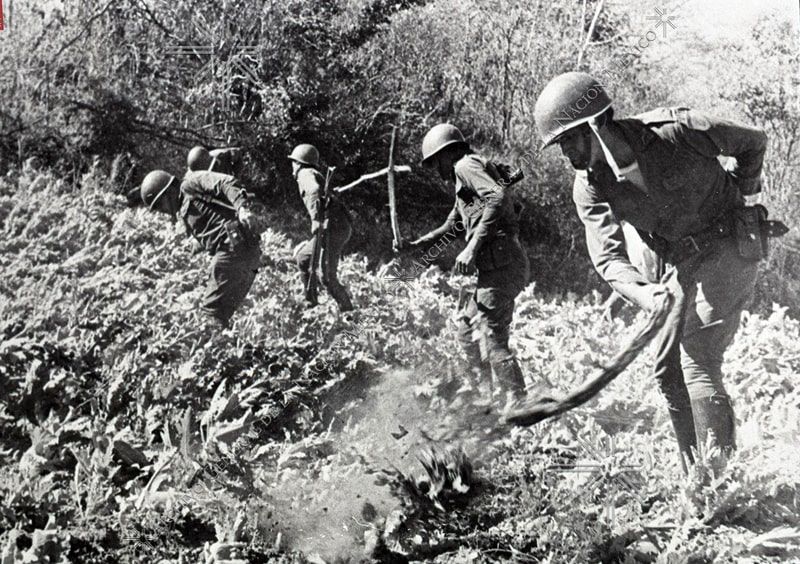The germinal years of Mexico's drug war policy
A central issue on the multilateral agenda between Mexico and the United States of America (USA) in the 1980s was drug trafficking. A joint offensive was proposed as part of the collaboration and cooperation agreements.

In the 1980s, a central issue on the multilateral agenda between Mexico and the United States of America (USA) was drug trafficking. As part of the collaboration and cooperation agreements between the two countries to face this social, economic, and political challenge, a joint offensive was proposed.
Although it did not manage to put an end to the problem, it did manage to reveal various problems that were documented in the records of the General Archive of the Nation (AGN, Archivo General de la Nación). Through presidential funds, especially those related to foreign policy and the bilateral relationship, we can enter into this aspect of an extraordinarily topical problem.
The history of the fight against drug trafficking in Mexico has its roots in the first decades of the 20th century, in the heat of the civil war. In 1916, Venustiano Carranza, head of the Constitutionalist Army, established the first policies against opium trafficking to the North American market through the border of Baja California Norte.
However, this fight took on greater force with the "war on drugs" promoted by the U.S. beginning in the 1970s. This policy set its sights on the main drug producers in the continent, with Mexico as one of its main targets, since our country was ceasing to be just a transit territory to become a producer.
Between 1975 and 1976, Operation Condor was deployed, one of the first operations against drug trafficking in our country. Its objective was to eradicate crops through the massive use of herbicides against marijuana and poppy plantations in the Sinaloa region. As a result of this first collaboration between both nations, permanent war against drug production and distribution was established in Mexico, which would be sustained by the Ministry of National Defense and the Attorney General's Office (PGR).
Documents from the PGR, located in President Miguel de la Madrid Hurtado's fund, reveal that by the mid-1980s the government's permanent campaign against drug producers had two main lines of action. On the one hand, it was aimed at destroying by sky marijuana and poppy plantations, whose distribution was identified in 13 regional sections considered as production centers. On the other hand, the Mexican army provided ground assistance by manually destroying the plantations in areas impregnable to aircraft through the "Canador" program.
The 1980s was a turning point in drug production and distribution in our country. Criminal groups dedicated to drug trafficking began to grow and gain greater power and operational capacity. This gave way to the formation of the first drug cartels in Mexico, which began to establish relationships with other criminal cells in the continent. Against this backdrop, the U.S. government, led by Ronald Reagan, exerted greater pressure on Mexico to take more forceful action. U.S. political pressure, which often translated into economic blackmail, led the Mexican government to intensify its actions during the administration of President Miguel de la Madrid Hurtado.
The reports submitted by the Mexican Army and the PGR to the President show a gradual increase in the number of plantations destroyed, drugs seized and suspects arrested for the crime of damage to health and drug trafficking. In 1982, 16,776 hectares of poppy had been destroyed, a figure that almost doubled by 1984 with the destruction of 24,333 hectares. The number of suspects arrested tripled from 3,873 in 1982 to 10,016 a couple of years later. However, in the case of the kilos of cocaine seized, the figures that were maintained remained the same with minimal changes and even decreased, as the 400 kilograms destroyed or seized fell to 325 in one year.
Multilateral cooperation between Mexico and the U.S. in the fight against drug trafficking and the incipient cartels led to collaboration between Mexican authorities and the U.S. investigative agency of the Drug Enforcement Administration (DEA). This situation triggered one of the biggest problems of the decade, since, in addition to the justified criticism of the interventionism it entailed, there was the assassination of DEA special agent Enrique Camarena on February 9, 1985.
This event provoked strong accusations from the U.S. towards Mexico, which were presented in February 1987 in the U.S. Congress through the report generated by the DEA and the Central Intelligence Agency (CIA). The document stated that in Mexico there was "a clear link between government authorities and drug trafficking and that, therefore, there is corruption"[4], although it recognized the commitment of our country in combating the illegal production and distribution of drugs, as well as in the investigation and prosecution of those guilty of the murder of the DEA agent.
Despite the war of words that some U.S. authorities waged against Mexico during those critical years, in the end, the idea prevailed that the drug trafficking problem was not the responsibility of a single country. In other words, it was recognized that it was an international phenomenon involving producing, distributing, and consuming countries, such as the United States itself. With such a conclusion, the U.S. government supported a war policy that has not found an end and, on the contrary, has intensified.
Through documentary sources, we have been able to take a look at a period in which a growing fight against drug trafficking in our country began. It is no coincidence that the boom in its production and distribution in Mexico were linked to the effects of the economic crisis of the decade, the change in the economic model, and the implementation of the neoliberal model. The economic, social, and political inequalities generated by the model caused certain social problems to become more pronounced, as was the case with drug production, distribution, and consumption.
Since then, the solutions provided by the Mexican authorities, pressured by a U.S. policy of war on drugs, have not focused on healing the social problem of inequality at the root, but on the prosecution and arrest of specific criminals to end the business. Thus, files such as those kept by the AGN allow us not only to reconstruct partial aspects of this long-standing struggle but also to identify trends that germinated in those years. Thus, we can draw lessons on the successes and limitations of the policy implemented to consciously assess the policy to be implemented in the present, with a view to a more prosperous, harmonious, and healthy future.




